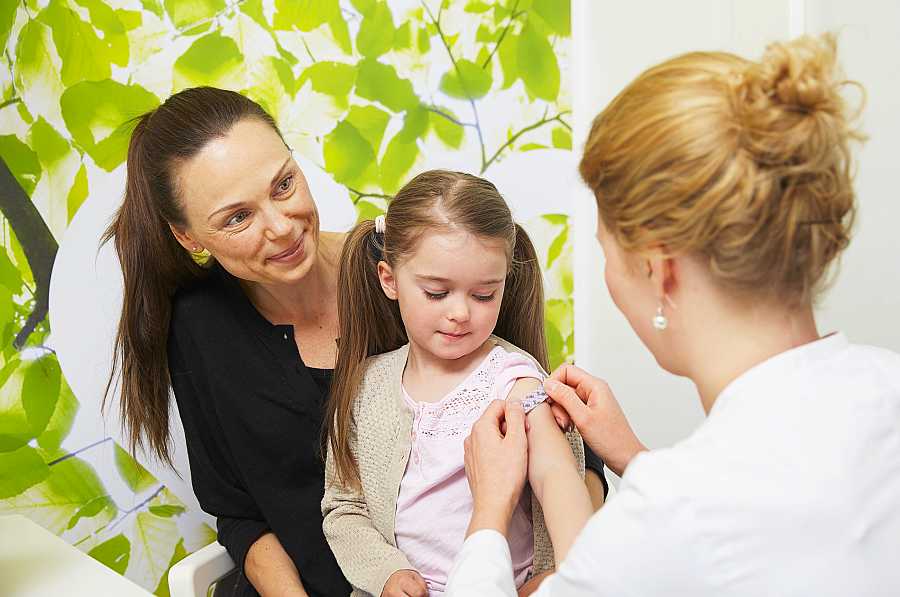Review finds little evidence for childhood vaccine fears

Measles are resurgent. Pertussis is epidemic. Meanwhile, the struggle to vaccinate young kids continues.
While scientific consensus hasn’t yet been enough to pop the balloon of anti-vaccine paranoia, a new review published online Tuesday by the journal Pediatrics adds further strength to a case that arguably needed no strengthening.
“Reassurance of vaccine safety remains critical for population health,” write the authors of a study that reviewed the literature on the safety of recommended routine vaccines.
After turning up more than 20,000 potentially relevant titles, the reviewers identified 67 studies that had a direct bearing on vaccine safety among children. Vaccines not available in the United States were excluded.
The review, requested by the Agency for Healthcare Research and Quality, builds on and updates a 2011 report from the Institute of Medicine that looked at potential adverse effects from vaccines in both children and adults. The new study’s findings are reassuring, if not surprising:
Our findings may allay some patient, caregiver, and health care provider concerns. Strength of evidence is high that MMR [measles, mumps and rubella] vaccine is not associated with the onset of autism in children; this conclusion supports findings of all previous reviews on the topic. There is also high-strength evidence that MMR, DTaP [diphtheria, tetanus, and pertussis], Td [tetanus, diphtheria], Hib [Haemophilus influenzae type B] and hepatitis B vaccines are not associated with childhood leukemia.
The key word in that first sentence is “may.” It’s hard to imagine how those unpersuaded by past studies and reviews would reverse course on the basis of this one. But the fact remains that the evidence dispelling the link between childhood vaccination and autism or leukemia is consistent and robust.
That doesn’t mean children’s vaccines don’t have any potential side effects, just that serious ones are highly uncommon. “Evidence was found for an association of several serious [adverse events] with vaccines; however, these events were extremely rare: absolute risk is low,” the reviewers conclude.
As an example, the study points to the vaccine against rotavirus, which can cause vomiting and diarrhea in children. The vaccine has been associated with a complication in which part of the intestine telescopes into itself. But one recent analysis found that happens in about five or fewer cases per 100,000 vaccinations. To put that risk in perspective, about 1 in 12,000 people will be struck by lighting in their lifetime.
But as any public health official can tell you, fears about vaccines don’t typically follow the tidy reasoning of a cost-benefit analysis. And when parents decline to vaccinate their kids out of ungrounded fears about autism or leukemia, long vanquished diseases can rise from the dead.
In California, there have been 60 measles cases recorded so far this year, with more than one-third in Orange County, where vaccine exemption rates approach 12 percent in some of the county’s wealthiest coastal enclaves. (While state law requires schoolchildren to be vaccinated, parents who sign a form are allowed to exempt their kids – too easily, some argue.)
The state is also in the middle of whooping cough epidemic, with 4,558 cases and 142 hospitalizations on the year, as of June 24. Three infants have died. The California Dept. of Public Health reports that among cases involving infants under 4 months old, only 16 percent of moms had received the recommended Tdap vaccine during pregnancy, and most not in the optimal 27-36 week window.
Pertussis cases in California reached their highest levels in over a half-century in 2010, when 9,120 cases were reported. A study published in Pediatrics last year found that clusters of unvaccinated individuals were partly responsible for the epidemic.
Those clusters have become more common, thanks to steady rises in the rate of vaccine exemptions in recent decades. In 2006, a study in JAMA reported that vaccine exemptions among children increased an average of 6 percent from 1991 to 2004. Dr. Paul A. Offit, head of infectious diseases at the Children’s Hospital of Philadelphia, wrote about the study for The Wall Street Journal at the time:
This increase occurred almost solely in states where philosophical exemptions were easy to obtain. Worse, states with easy-to-obtain philosophical exemptions had twice as many children suffering from pertussis … than states with hard-to-obtain philosophical exemptions.
Dr. Offit compared the vaccination requirements to seat-belt laws and other safety regulations: “We don't allow philosophical exemptions to restraining young children in car seats, to smoking in restaurants or to stopping at stop signs,” he wrote. Yet we do for vaccines.
Last year, JAMA published a helpful map of the United States that shows where kindergarten exemption rates are highest: the Pacific Northwest, the Great Lakes states, the Upper Northeast, and Arizona and Colorado outpace the rest of the nation. Nationwide, the median vaccination rates for measles and pertussis are around 95 percent.
Colorado’s vaccination rates are especially dismal, with less than 86 percent of kindergartners receiving the MMR vaccine. One mother of four children, all unvaccinated, told The Wall Street Journal she opposed a proposed rule that requiring parents to undergo counseling on the merits of vaccination before opting out. “I want parents to be able to make the decisions about what happens to their children,” she told the paper.
Such parents are unlikely to be moved by reports of this week’s fresh review of the evidence. And that can lead to serious consequences, not just for their kids but for their unwitting friends and classmates as well.
Related posts
Once ‘Eliminated’ in U.S., Measles Makes a Comeback
Photo by Apotek Hjartat via Flickr.

